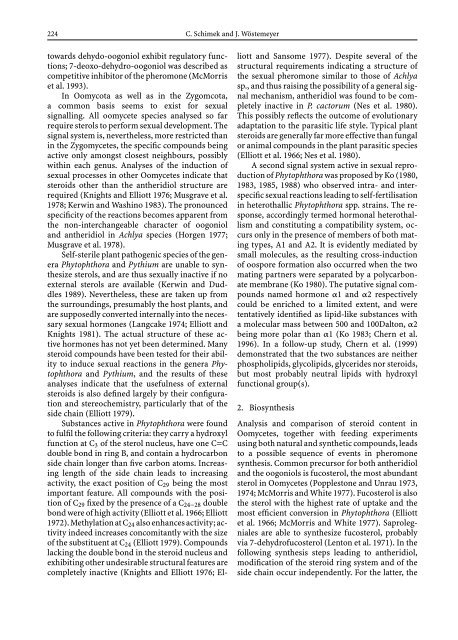Growth, Differentiation and Sexuality
Growth, Differentiation and Sexuality
Growth, Differentiation and Sexuality
Create successful ePaper yourself
Turn your PDF publications into a flip-book with our unique Google optimized e-Paper software.
224 C. Schimek <strong>and</strong> J. Wöstemeyer<br />
towards dehydo-oogoniol exhibit regulatory functions;<br />
7-deoxo-dehydro-oogoniol was described as<br />
competitive inhibitor of the pheromone (McMorris<br />
et al. 1993).<br />
In Oomycota as well as in the Zygomcota,<br />
a common basis seems to exist for sexual<br />
signalling.Alloomycetespeciesanalysedsofar<br />
require sterols to perform sexual development. The<br />
signal system is, nevertheless, more restricted than<br />
in the Zygomycetes, the specific compounds being<br />
active only amongst closest neighbours, possibly<br />
within each genus. Analyses of the induction of<br />
sexual processes in other Oomycetes indicate that<br />
steroids other than the antheridiol structure are<br />
required (Knights <strong>and</strong> Elliott 1976; Musgrave et al.<br />
1978; Kerwin <strong>and</strong> Washino 1983). The pronounced<br />
specificity of the reactions becomes apparent from<br />
the non-interchangeable character of oogoniol<br />
<strong>and</strong> antheridiol in Achlya species (Horgen 1977;<br />
Musgrave et al. 1978).<br />
Self-sterile plant pathogenic species of the genera<br />
Phytophthora <strong>and</strong> Pythium are unable to synthesize<br />
sterols, <strong>and</strong> are thus sexually inactive if no<br />
external sterols are available (Kerwin <strong>and</strong> Duddles<br />
1989). Nevertheless, these are taken up from<br />
the surroundings, presumably the host plants, <strong>and</strong><br />
are supposedly converted internally into the necessary<br />
sexual hormones (Langcake 1974; Elliott <strong>and</strong><br />
Knights 1981). The actual structure of these active<br />
hormones has not yet been determined. Many<br />
steroid compounds have been tested for their ability<br />
to induce sexual reactions in the genera Phytophthora<br />
<strong>and</strong> Pythium, <strong>and</strong>theresultsofthese<br />
analyses indicate that the usefulness of external<br />
steroids is also defined largely by their configuration<br />
<strong>and</strong> stereochemistry, particularly that of the<br />
side chain (Elliott 1979).<br />
Substances active in Phytophthora were found<br />
to fulfil the following criteria: they carry a hydroxyl<br />
function at C3 of the sterol nucleus, have one C=C<br />
double bond in ring B, <strong>and</strong> contain a hydrocarbon<br />
side chain longer than five carbon atoms. Increasing<br />
length of the side chain leads to increasing<br />
activity, the exact position of C29 being the most<br />
important feature. All compounds with the position<br />
of C29 fixedbythepresenceofaC24−28 double<br />
bond were of high activity (Elliott et al. 1966; Elliott<br />
1972). Methylation at C24 also enhances activity; activity<br />
indeed increases concomitantly with the size<br />
of the substituent at C24 (Elliott 1979). Compounds<br />
lacking the double bond in the steroid nucleus <strong>and</strong><br />
exhibiting other undesirable structural features are<br />
completely inactive (Knights <strong>and</strong> Elliott 1976; El-<br />
liott <strong>and</strong> Sansome 1977). Despite several of the<br />
structural requirements indicating a structure of<br />
the sexual pheromone similar to those of Achlya<br />
sp., <strong>and</strong> thus raising the possibility of a general signal<br />
mechanism, antheridiol was found to be completely<br />
inactive in P. cactorum (Nes et al. 1980).<br />
This possibly reflects the outcome of evolutionary<br />
adaptation to the parasitic life style. Typical plant<br />
steroids are generally far more effective than fungal<br />
or animal compounds in the plant parasitic species<br />
(Elliott et al. 1966; Nes et al. 1980).<br />
Asecondsignalsystemactiveinsexualreproduction<br />
of Phytophthora was proposed by Ko (1980,<br />
1983, 1985, 1988) who observed intra- <strong>and</strong> interspecific<br />
sexual reactions leading to self-fertilisation<br />
in heterothallic Phytophthora spp. strains. The response,<br />
accordingly termed hormonal heterothallism<br />
<strong>and</strong> constituting a compatibility system, occurs<br />
only in the presence of members of both matingtypes,A1<strong>and</strong>A2.Itisevidentlymediatedby<br />
small molecules, as the resulting cross-induction<br />
of oospore formation also occurred when the two<br />
mating partners were separated by a polycarbonate<br />
membrane (Ko 1980). The putative signal compounds<br />
named hormone α1 <strong>and</strong>α2 respectively<br />
could be enriched to a limited extent, <strong>and</strong> were<br />
tentatively identified as lipid-like substances with<br />
a molecular mass between 500 <strong>and</strong> 100Dalton, α2<br />
being more polar than α1 (Ko 1983; Chern et al.<br />
1996). In a follow-up study, Chern et al. (1999)<br />
demonstrated that the two substances are neither<br />
phospholipids, glycolipids, glycerides nor steroids,<br />
but most probably neutral lipids with hydroxyl<br />
functional group(s).<br />
2. Biosynthesis<br />
Analysis <strong>and</strong> comparison of steroid content in<br />
Oomycetes, together with feeding experiments<br />
using both natural <strong>and</strong> synthetic compounds, leads<br />
toapossiblesequenceofeventsinpheromone<br />
synthesis. Common precursor for both antheridiol<br />
<strong>and</strong> the oogoniols is fucosterol, the most abundant<br />
sterol in Oomycetes (Popplestone <strong>and</strong> Unrau 1973,<br />
1974; McMorris <strong>and</strong> White 1977). Fucosterol is also<br />
the sterol with the highest rate of uptake <strong>and</strong> the<br />
most efficient conversion in Phytophthora (Elliott<br />
et al. 1966; McMorris <strong>and</strong> White 1977). Saprolegniales<br />
are able to synthesize fucosterol, probably<br />
via 7-dehydrofucosterol (Lenton et al. 1971). In the<br />
following synthesis steps leading to antheridiol,<br />
modification of the steroid ring system <strong>and</strong> of the<br />
side chain occur independently. For the latter, the

















